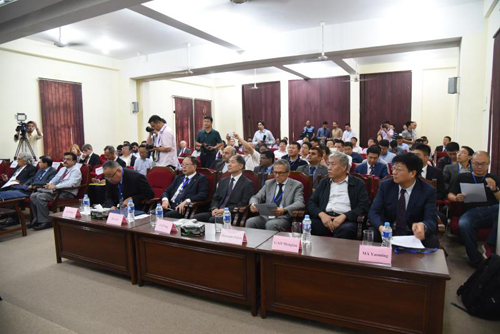The silk Road Economic Belt and the 21st Century Maritime Silk Road covers more than 70 countries and 4.4 billion people (63% of the world). Due to the active underlying geological structure, rapid tectonic uplift, and the obvious climate differences, natural hazards (e.g. earthquakes, landslides, and debris flow etc.) occur frequently along the Silk Road Economic Belt. Moreover, due to climate changes and active submarine earthquakes, natural hazards (e.g. Typhoons, tropical storm surges and tsunamis) along the 21st Century Maritime Silk Road have been attracting increasing attention. These frequently occurring natural hazards along the Belt and Road seriously affect the security and social development of multiple nations. It is thus necessary to conduct fundamental research on hazard mechanisms to provide scientific guidance for natural hazards prevention, construction of major infrastructure, and disaster relief with high efficiency and precision.
In order to guarantee the security of the China-Pakistan Economic Corridor and provide scientific supports to the implementation of the Belt and Road Program, the 2017 CPEC Natural Disaster and Integrated Disaster Mitigation Conference & The 2nd Belt and Road Natural Disaster and Integrated Disaster Mitigation Conference was held on July 17th and 18th in Islamabad, Pakistan. The conference which was jointly hosted by Chinese Academy of Sciences and Pakistan Academy of Sciences, and organized by the Institute of Mountain Hazards and Environment, Pakistan Karakoram International University etc. attracted over 140 experts, scientific staffs or engineering technology staffs who were from 12 different countries, including China, Pakistan, Russia, Italy, Iran, Sri Lanka, Nepal, Hungary, Austria, Germany etc.
The deputy chairman of Chinese Academy of Sciences, Prof. Jie Zhang attended the conference and delivered a speech as the representative of the organizer. Prof. Zhang stated clearly that the CPEC was located in the intersection area of Himalaya Mountains, Karakoram Mountains and Hindu Kush Mountains, where existed a great number of advanced scientific research topics and major problem on disaster prevention and relief. He also added that China and Pakistan sides have a vast potential for future scientific cooperation, this conference would be a great opportunity to enhance the science and technology cooperation in disaster prevention and relief field with engineering security field. Also, it was essential to strengthen the cooperation with other participating nations to comprehensively improve disaster risk prevention capacity, comprehensively support the CPEC construction and serve the implementation of the national strategy of the Belt and Road. He wished the conference a complete success eventually. The General Secretary of Pakistan Ministry of Science and Technology, Prof. Fazal Abbas Maken, the General Secretary of Pakistan Academy of Sciences, Prof. Zabta Khan Shinwari, the deputy president of Karakoram International Univeristy, Prof. M. Asif Khan, the General Director of International Cooperation Bureau of Chinese Academy of Sciences, Mr. Jinghua Cao attended the opening ceremony and delivered speeches.
The Academicians of Chinese Academy of Sciences, Prof. Dahe Qin, Prof. Peng Cui and Prof Jun Xia, the General Director of Pakistan Metrology Bureau, Dr. Ghulam Rasul, Prof. Alessandro Pasuto from the Institute of Hydro Geological Disaster Research of Italy National Research Council, Prof. Charles W.W. NG of Hong Kong University of Science and Technology etc. delivered the Invited Lectures. During the discussing period of the conference, participating experts and researchers had a deep communication and discussion about CPEC earthquake, collapse landslide, debris flows, flood, avalanche lake, snow and other typical natural disaster and their information accumulation, formation mechanism, judging methods, dynamic process, risk qualitative assessment, monitoring and early warning, key preventing and treating technologies, disaster information sharing, risk management and post-disaster reconstruction. Also the agreement on the management of major engineering disaster risk prevention and the mechanism of research cooperation was reached, as foundation for enhance comprehensive cooperation in disaster prevention and relief.
In order to respond and serve the Belt and Road and China Pakistan Economic Corridor construction, Chinese Academy of Science carried out the Belt and Road Natural Disaster and Integrated Disaster Mitigation International Cooperation Research Plan and STS Plan for Natural Disaster Risk Assessment and Disaster Reduction Solution Research in 2016 and 2017 respectively to provide scientific supports for the regional security and sustainable development for the CPEC and the Belt and Road construction. During the conference, some significant phased objectives, which provided solid foundation to serve the Belt and Road, were presented. It was preliminarily determined in the conference that the 2nd Belt and Road Natural Disaster and Integrated Disaster Mitigation Conference would be held in China in 2018. It would be significant to gather global famous experts and researchers as think tank to serve the construction of the Belt and Road and build an international first- class disaster reduction and prevention cooperation mechanism and platform for the Belt and Road.

The Academic Communication Seminar

Group Photo of the Participating Candidates
